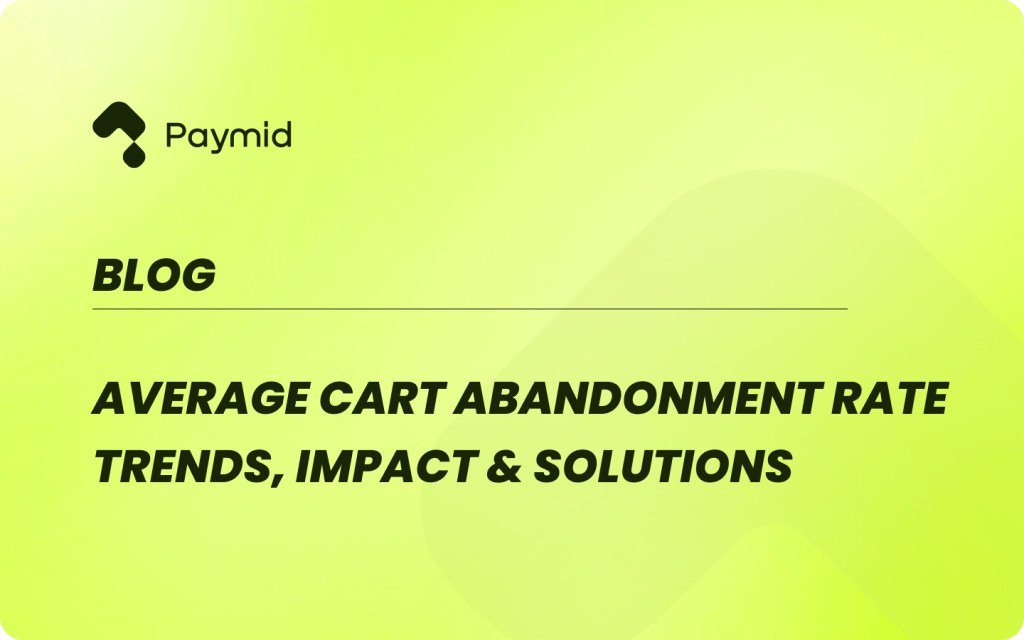Average Cart Abandonment Rate: Trends, Impact, & Solutions

Cart abandonment continues to challenge online retailers, with nearly 70% of shoppers leaving items behind in their virtual carts. For e-commerce businesses, this persistent issue directly affects conversion rates and revenue [1].
As the digital marketplace evolves in 2024, understanding the latest trends and triggers behind cart abandonment is more important than ever. By addressing these factors, businesses can refine the shopping experience, reduce abandonment, and ultimately increase sales.
⚡ Key Takeaways
Understanding Cart Abandonment Metrics
To improve their online shopping experience and boost sales, e-commerce businesses need to understand cart abandonment metrics. These metrics provide valuable insights into customer behavior and help identify areas for improvement in the purchasing process.
Calculating Cart Abandonment Rate
The cart abandonment rate is a crucial metric that shows the percentage of shoppers who add items to their cart but don’t complete the purchase. To calculate this rate, you can use a simple formula:
Cart Abandonment Rate = 1 – (Number of Completed Purchases / Number of Shopping Carts Created) x 100 [2]
For example, if you have 45 completed purchases out of 200 shopping carts created, your cart abandonment rate would be 77.5%.
Industry Benchmarks for 2024
In 2024, the average cart abandonment rate across industries is approximately 71.61% [3]. However, this rate varies significantly depending on the sector:
- Fashion industry: 77%
- Pet care industry: 63%
- Luxury and jewelry: 74%
- Food and beverage: 44%
It’s worth noting that cart abandonment rates have been steadily increasing over the years. In 2006, the average rate was 59.8%, and by 2021, it had risen to 69.82% [4].
Impact on E-commerce Revenue
Cart abandonment has a substantial impact on e-commerce revenue. According to recent studies, the products left in abandoned carts are worth around $4 trillion annually. This represents a significant opportunity for businesses to recover lost sales [5].
By optimizing the checkout process and addressing usability issues, businesses could potentially increase their conversion rates by up to 35.26%. This improvement could help recover up to $260 billion in lost order revenue across the e-commerce industry [6].
Comparison of Mobile vs Desktop
When it comes to online shopping, the device used can significantly impact cart abandonment rates.
Mobile Abandonment Statistics
Mobile devices have become the go-to choice for online shopping, accounting for more than two-thirds of all e-commerce sessions. However, this convenience comes at a cost. Mobile users have the highest cart abandonment rate, with a staggering 85.65% of shoppers failing to complete their purchases [7]. This high rate is particularly concerning given that mobile traffic makes up 68% of all ecommerce sessions.
Desktop Abandonment Rates
Desktop computers provide a more comfortable viewing experience thanks to larger screens. This advantage translates to lower cart abandonment rates compared to mobile devices. On average, desktop ecommerce sessions have a cart abandonment rate of 73.07%. While this is still a significant percentage, it’s notably lower than mobile rates [8].
Factors Affecting Device-specific Abandonment
Several factors contribute to the difference in abandonment rates between mobile and desktop:
- Screen size: Larger desktop screens make it easier for shoppers to view products and navigate through the checkout process.
- User experience: Many e-commerce sites still lack adequate mobile optimization, leading to frustration and abandonment on smaller screens.
- Purchase value: Consumers tend to spend more when shopping on desktop computers. In December 2023, the average value of desktop purchases was around $159, compared to $100-$105 for mobile and tablet purchases [9].
- Convenience vs. commitment: Mobile devices offer easy browsing and adding items to carts, but users often prefer desktops for completing more expensive purchases.
To address these issues, businesses should prioritize mobile design and create responsive layouts that work well across all devices. By standardizing the shopping cart and checkout experience, retailers can provide a familiar and user-friendly process regardless of the device used.
Read More:
- How Smart Routing Enhances Intelligent Payment Systems
- Merchant Initiated Transactions (MITs): Steps, Types & Compliance
- Smart Routing Payment: Components, Benefits & Process
- Guide to Payment Tokenization & Card Security
Psychological Factors Behind Cart Abandonment
Understanding the psychological factors that lead to cart abandonment is crucial for e-commerce businesses looking to boost their conversion rates. Let’s explore some key factors that influence shoppers’ decisions to abandon their carts.
1. Decision Paralysis
Choice overload can significantly impact a shopper’s ability to make a purchase decision. Research shows that when consumers are presented with too many options, they often end up less satisfied with their final choice or avoid making a decision altogether. This phenomenon, known as decision paralysis, can lead to cart abandonment as shoppers feel overwhelmed by the sheer volume of choices available.
2. Price Sensitivity
One of the primary reasons for cart abandonment is price sensitivity, particularly when it comes to unexpected costs. Studies have shown that 48% of US online shoppers have abandoned a cart within the last three months due to high extra costs such as shipping, taxes, and fees [10]. To address this issue, businesses should consider offering free shipping or communicating all costs upfront to avoid surprises at checkout.
3. Trust and Security Concerns
Security plays a crucial role in a shopper’s decision to complete a purchase. According to recent studies, 48% of consumers cite website security as a major concern, while 45% worry about the use and security of their personally identifiable information (PII) [11].
To combat these concerns, e-commerce sites should implement robust security measures, display trust signals, and offer secure payment options to build consumer confidence.
4. FOMO (Fear of Missing Out)
The fear of missing out (FOMO) can be a powerful motivator in e-commerce. By creating a sense of urgency and scarcity, businesses can tap into this psychological principle to encourage faster purchase decisions. Tactics such as limited-time offers, low stock notifications, and social proof can effectively leverage FOMO to reduce cart abandonment rates and drive conversions [12].
Technological Solutions to Combat Cart Abandonment
1. AI-powered Personalization
AI has a significant impact on reducing cart abandonment by personalizing the shopping experience. By analyzing customer browsing habits, previous purchases, and social media activity, AI tailors product recommendations and promotions that resonate with individual shoppers. This level of personalization makes the shopping experience more engaging and encourages customers to complete their purchases.
2. One-click Checkout Options
One-click checkout allows shoppers to purchase items in their cart with a single click. This streamlined process eliminates the need for customers to manually input their details.
By storing payment information securely, one-click checkout reduces the gap between browsing and purchasing, catering perfectly to impulse buys. This feature can significantly increase turnover and conversion rates [13].
3. Real-time Customer Support
Real-time assistance offers a proactive approach to reducing cart abandonment rates. Solutions like AI-powered chatbots can engage customers instantly, providing personalized support and addressing concerns as they arise.
For example, if a customer hesitates during checkout, a chatbot can offer assistance, answer questions about products, shipping, or payment options, and guide them through the process [14].
4. Retargeting Strategies
Retargeting ads are an effective way to reduce cart abandonment. These ads use cookies to track visitors who added products to their cart but didn’t complete the purchase.
By displaying personalized ads on other websites or social media platforms, businesses can remind customers of their abandoned carts and offer incentives to complete the purchase. Dynamic ads, which showcase previously viewed or recommended products, have shown to be particularly effective in re-engaging potential customers [15].
What Is The Future Of Cart Abandonment?
The cart abandonment rate continues to be a significant challenge for online retailers in 2024, with an average of 71.61% across industries. This metric has a huge impact on e-commerce revenue, with abandoned carts representing around $4 trillion in potential sales annually. By understanding the factors behind cart abandonment, including device-specific issues and psychological influences, businesses can develop strategies to address these challenges.
To tackle cart abandonment, companies are turning to cutting-edge solutions like AI-powered personalization, one-click checkout options, and real-time customer support. These technologies, combined with a deep understanding of customer behavior, can help businesses create a more seamless and engaging shopping experience. As the e-commerce landscape evolves, retailers who adapt to these changes and prioritize the customer journey will be better positioned to boost their conversion rates and grow their online sales.
References
[1] – Researchgate – The Determinants of Consumers’ Shopping Cart Abandonment –https://www.researchgate.net/publication/225620227_The_determinants_of_consumers’_shopping_cart_abandonment [2] – Infobip – How To Calculate Cart Abandonment Rate. https://www.infobip.com/blog/how-to-calculate-cart-abandonment-rate [3] – Capturly – Average Cart Abandonment Rate By Industry. https://capturly.com/blog/average-cart-abandonment-rate-by-industry/ [4] – Statista – Online Shopping Cart Abandonment Rate Worldwide. https://www.statista.com/statistics/477804/online-shopping-cart-abandonment-rate-worldwide/ [5] – Webuters – Shopping Cart Abandonment. https://www.webuters.com/shopping-cart-abandonment-statistics#:~:text=According%20to%20a%20recent%20study,resolving%20the%20cart%20abandonment%20issue. [6] – Wisernotify – Cart Abandonment Stats. https://wisernotify.com/blog/cart-abandonment-stats/ [7] – Hotjar – 23 cart abandonment stats you need to know to improve sales in 2024 https://www.hotjar.com/blog/cart-abandonment-stats/ [8] – Sciencedirect – Utilizing SEM-RFC to predict factors affecting online shopping cart abandonment during the COVID-19 pandemic.https://www.sciencedirect.com/science/article/pii/S2405844022025816 [9] – WPexperts – 10 Ways to Reduce Shopping Cart Abandonment Rate on Your E-commerce Store.
https://wpexperts.io/blog/reduce-shopping-cart-abandonment-rate/ [10] – Bigcommerce – The Keys to Abandoned Cart Recovery and Reducing Lost Sales
https://www.bigcommerce.com/articles/ecommerce/abandoned-carts/#:~:text=Nothing%20turns%20shoppers%20off%20more,and%20fees)%20were%20too%20high. [11] – Researchgate – Customers’ Perception of Cybersecurity Risks in E-commerce Websites. https://www.researchgate.net/publication/375432738_Customers’_perception_of_cybersecurity_risks_in_E-commerce_websites [12] – Forbes – How E-Commerce Leaders Can Use The Power Of FOMO To Drive More Conversions.
https://www.forbes.com/councils/forbesbusinessdevelopmentcouncil/2023/03/27/how-e-commerce-leaders-can-use-the-power-of-fomo-to-drive-more-conversions/ [13] – Weareplanet – How does one-click checkout work? https://www.weareplanet.com/blog/one-click-checkout [14] – Providing Customer Support at Scale with Ecommerce Chatbots. https://www.bigcommerce.com/articles/ecommerce/chatbots/ [15] – Swym – https://swym.it/the-art-of-conversion-mastering-personalized-display-ads-for-ecommerce-success/ https://swym.it/the-art-of-conversion-mastering-personalized-display-ads-for-ecommerce-success/

